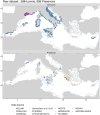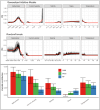Mapping the habitat refugia of Isidella elongata under climate change and trawling impacts to preserve Vulnerable Marine Ecosystems in the Mediterranean
- PMID: 38485718
- PMCID: PMC10940633
- DOI: 10.1038/s41598-024-56338-1
Mapping the habitat refugia of Isidella elongata under climate change and trawling impacts to preserve Vulnerable Marine Ecosystems in the Mediterranean
Abstract
The bamboo-coral Isidella elongata is a key habitat-forming species in the deep Mediterranean Sea. This alcyonacean is listed as an indicator of Vulnerable Marine Ecosystems (VMEs) and as Critically Endangered due to bottom trawling impacts. In this work, a modeling approach was used to predict and map the habitat suitability of I. elongata in the Mediterranean Sea under current environmental conditions. Occurrence data were modeled as a function of environmental parameters. Using climate change scenarios and fishing effort data, the risk of climate change and fisheries impacts on habitat suitability were estimated, and climate refugia were identified. A drastic loss of habitat is predicted, and climate change scenarios suggest a loss of 60% of suitable habitats by 2100. In the central Mediterranean, climate refugia overlapped with active fishing grounds. This study represents the first attempt to identify hot spots for the protection of soft bottom Vulnerable Marine Ecosystems for the entire Mediterranean Sea, and highlights areas most at risk from trawling. This work is relevant to the objectives of the EU Marine Strategy Framework and Maritime Spatial Planning Directives, the Biodiversity Strategy for 2030 regarding priority areas for conservation.
© 2024. The Author(s).
Conflict of interest statement
The authors declare no competing interests.
Figures








References
-
- FAO. International Guidelines for the Management of Deep-sea Fisheries in the High Seas | GLOBEFISH | Food and Agriculture Organization of the United Nations. 73 https://www.fao.org/in-action/globefish/publications/details-publication... (2009).
-
- European Parliament & Council of the european union. Directive 2008/56/EC of the European Parliament and of the Council of 17 June 2008 establishing a framework for community action in the field of marine environmental policy (Marine Strategy Framework Directive) (Text with EEA relevance. (2008).
-
- Proposal for a regulation of the European parliament and of the council on nature restoration. (2022).
-
- Mytilineou Ch, et al. New cold-water coral occurrences in the Eastern Ionian Sea: Results from experimental long line fishing. Deep Sea Res. Part II. 2014;99:146–157. doi: 10.1016/j.dsr2.2013.07.007. - DOI
MeSH terms
LinkOut - more resources
Full Text Sources

